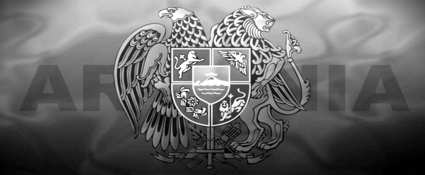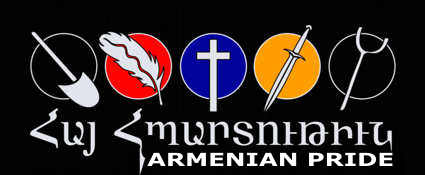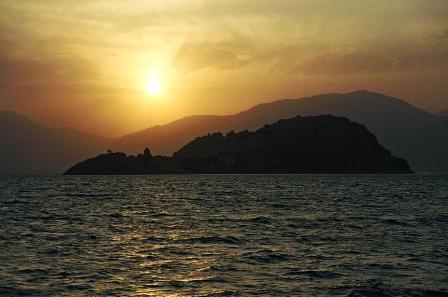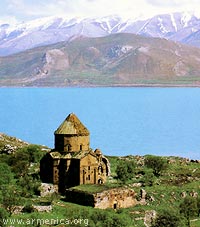The city of Van is located near the SE corner of the large salty Lake Van. The modern city, built near, but not over the old one is not remarkable, and the old destroyed Armenian sections were left to melt away with time. The old Van Fortress still stands. The Armenians defended themselves against Turkish troops for 5 weeks before the Russians arrived in May,1915. The Russians left 6 weeks later, with many Armenians choosing to leave with them, and settle in the East.
Lake Van
 |
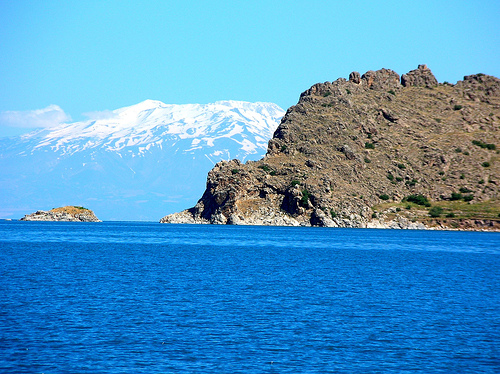 |
Lies in Western Armenia, todays SE Turkey. The city of Van is in the SE corner of the large lake, with a number of Armenian monasteries along the shores and on the islands in the lake. The most famous island is that of Aghtamar, on the southern shore towards the east. A few kilometers to the SW of Lake Van lies the town of Bitlis, and the province of Mush lies past the west of the region. North of Lake Van was the city of Tondrak, center of the medieval Armenian hippie Tondrakians
sect. Tondrakians were members of an anti-feudal, heretical Christian sect that flourished in medieval Armenia between the early 9th century and 11th century and centered around the city of Tondrak, north of Lake Van.Cultural history
The lake was the centre of the Armenian kingdom of Urartu from about 1000 BC, and the capital of Urartu, Tushpa, was on the shore of Lake Van (on the site of the medieval castle of Van, west of Van city).It served as the capital of the Urartians during the Iron Age.
Along with Lake Sevan in today's Armenia and Lake Urmia in today's Iran, Van was one of the three great lakes of the Armenian Kingdom, referred to as the seas of Armenia. Along its shores and on several islands (Arter, Lim, Charpanak, etc.) the remains of Armenian churches and monasteries can be found. The best preserved is the tenth-century Church of the Holy Cross (Armenian Սուրբխաչ, Surb Chatsch, scientific transliteration Surb xač') located on Akdamar Island. It was built by king Gagik Artzruni between 915 and 921. Reliefs on the external walls represent Biblical stories such as Adam and Eve, Jonah and the whale, David and Goliath, etc.
Other important historical monuments include Van Kalesi (Castle of Van) on the Lake's eastern shore. The modern city of Van is located to the east of this castle.
The Lake Van region is also the origin of the popular Van Kedisi breed of cat, noted for among other things its unusual fascination with water (a very rare trait among cats, which generally dislike being immersed in water).
Since about 1995 there have been reported sightings of a 'Lake Van monster' about 15 metres in length named Van Canavarı. Unal Kozak, a teaching assistant at Van University, has interviewed about a thousand people who claim to have seen the monster, and has written a book on the subject. Sceptics point out that the region would benefit from tourist revenue and a hoax might attract visitors.
Lake Van, Turkey
Armenian: Աղթամար
Aghtamar Island, with the Xth century Church of the Holy Cross is the premier attraction in the Lake Van area. The island also had other religious buildings, a harbor, a palace, and residences, all of which are now destroyed. These structures were both home to the Arzruni royal family, and the Holy See of an independent Armenian Catholicosate from 1113 to the end of the XIXth century.
The facade of the Church of the Holy Cross is covered in fanstastic relief sculptures depicting scenes from the Old Testament. Inside there are faint remains of frescoes.
The Armenian chronicler Thovma Ardzruni competently reports the important building work accomplished by Derenik and his son Gagik, kings of Vaspurakan. He provides interesting information about the building of the harbor, church, palace and other edifices on the island of Akhtamar. Of all those buildings there remains but the church of Surp Khach (Holy Cross), erected between 915 and 921 by the outstanding architect, sculptor, and painter, Manuel, under the patronage of King Gagik Ardzruni. This is one of the finest jewels of Armenian architecture, and that is why it has received the special attention of both Armenian and foreign academics. In its design and conception of volumes and surfaces, this sanctuary is an intellectually original variation of the cruciform and central cupola'd churches of the high Middle Ages, of which the church of Surp Echmiadzin of Zoradir is a specimen discovered by Italian archeologists at Vaspurakan. It differs from them in an unprecedented richness of shapes and particularly in the number as well as variety of its mural high reliefs, which constitute an innovation in Armenian architecture.
Because if those magnificent high reliefs it is truly difficult to consider the church of Akhtamar only from the standpoint of architecture. Three bands of high reliefs cover all the walls of the church and are grouped according to the theme they represent. Side by side with religious subjects, Old and New Testament, are found numerous scenes from daily life such as hunting, work, and festivities, which are precious sources of information on the customs of the 10th century and mark the entrance of lay ideas into the realm of art. The high reliefs, representing among others the Virgin Mary, Christ, the Apostles, David and Goliath, Abraham and Isaac, Adam and Eve, King Gagik, hunting and the harvesting of grapes, are rendered with extraordinary dynamic realism; they portray authentically spiritual and ordinary life and illustrate the national character as well as human kind. All the interior walls and even the cupola are covered with beautiful frescoes, the best of which is the one painted on the high altar wall representing the triumphal entry of Jesus into Jerusalem, sitting on a white ass. Because of its novel conception, its high reliefs and frescoes of rare artistic value, the church of Akhtamar deserves a particular place in the history of not only Armenian, but also world architecture. Akhtamar now lies in Turkish territory on Lake Van. [Paragraph Source: Monuments of Armenia]
ARMENIAN CHURCH IN TURKEY TO BE RESTORED -- The Turkish Government has allocated $1.9 million to rebuild the ancient Armenian Church of Akhtamar (Akdamar) on an island in the middle of Lake Van in Eastern Turkey. Currently underway, the stabilization and conservation of the Church and its excellent stone relief, will enable it to again function as a place of worship.
The Historical Heritage Protection Foundation (TMKV), based in Istanbul, and the New York-based Landmarks Foundation spearheaded the effort and are working closely with architects appointed by the Patriarch of the Armenian Church, His Beatitude Mesrob II, as well as prominent American and Turkish Universities.
Decades of political wrangling kept the 10th century structure from being maintained, but this year, with the help of the Patriarch of the Armenian Church, His Beatitude Mesrob II, an intervention to save the endangered structure is underway. Verkin Arioba, director of TMKV, indicated, "The Armenian Patriarch in Turkey supports the project. He is refreshingly modern and forward thinking." TMKV Chairman Savit Osman Avci, a former Speaker of the Turkish Assembly, played a pivotal role in getting permits from Turkish authorities.
"Armenian architects were consulted to ensure that Akhtamar's reconstruction meets international standards," added David L. Phillips who led a study at American University involving architects from around the world including Armenia. "The Church is a world famous example of the spectacular medieval Armenian ecclesiastical architecture. Its restoration will promote rapprochement between Turkey and Armenia particularly if Turkey agrees to open its border with Armenia allowing normal travel, trade, and tourism."
An Advisory Board organized by the Landmarks Foundation and the Historical Heritage Protection Foundation consists of archeology and fresco experts including Frank Matero, Chair of Preservation, and Dana Tomlin, Professor of Landscape Architecture and GIS Geographic Information Systems at the University of Pennsylvania, who are members of the committee. "Cooperation among the University of Pennsylvania, Istanbul Technical and Van Universities are an important component of this project" said Arioba.
The University of Pennsylvania, in conjunction with the Turkish Universities, will offer a course in which students will analyze opportunities and constraints for the utilization and protection of Akhtamar Island. The course will employ state-of-the-art information technology to document the existing site, to identify its vulnerabilities, to explore its potential, to make recommendations for its future and to anticipate the impact of those recommendations.
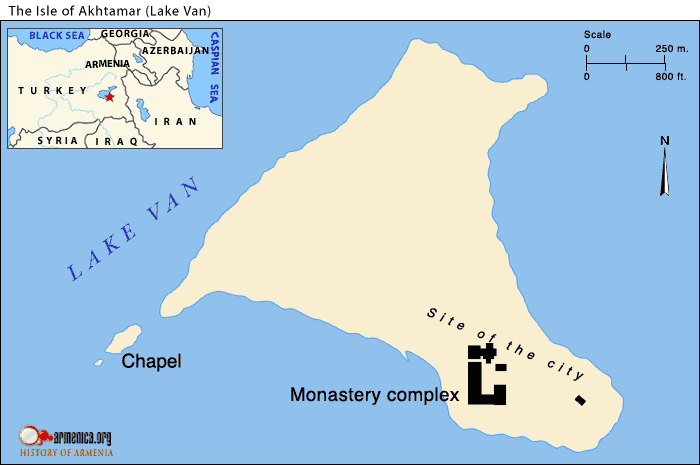
|
Copyright © 2008 www.kaloustian.nl - www.kaloustian.eu. All Rights Reserved.
|
